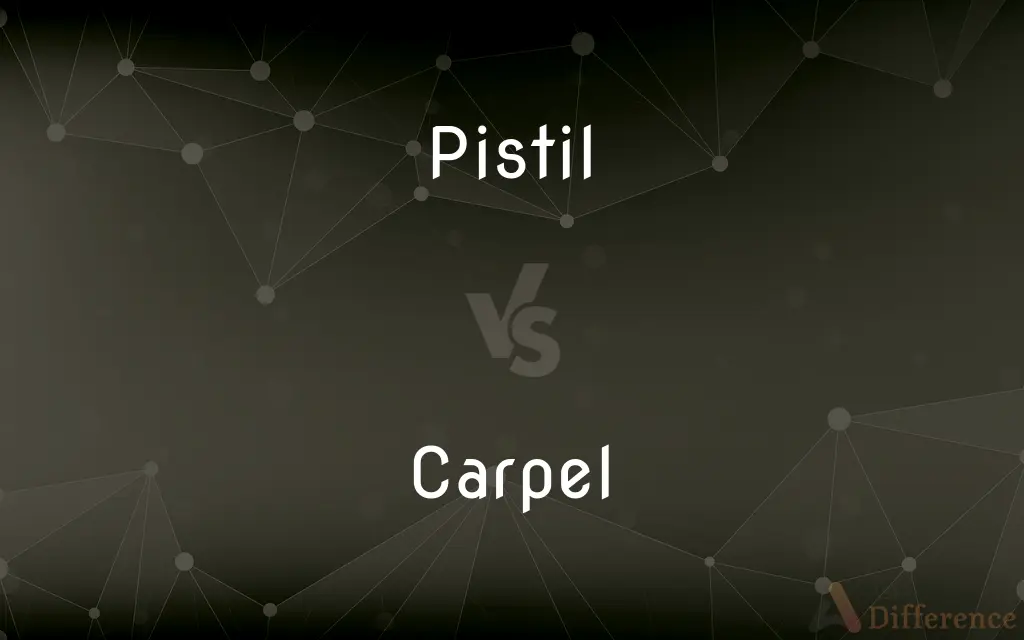Pistil vs. Carpel — What's the Difference?
By Tayyaba Rehman & Maham Liaqat — Updated on March 10, 2024
A pistil is the female reproductive part of a flower, often composed of multiple fused carpels, whereas a carpel is the individual ovule-bearing unit that can form a pistil when several are fused together.

Difference Between Pistil and Carpel
Table of Contents
ADVERTISEMENT
Key Differences
A pistil serves as the female reproductive part of a flower, functioning to receive pollen and produce seeds. It may consist of one or more carpels, indicating a composite structure in many flowers. On the other hand, a carpel is considered the fundamental unit of the pistil, each containing an ovary, a style, and a stigma.
In some plants, the pistil is formed from a single carpel, making the terms seemingly interchangeable. However, the distinction lies in the composition, where a pistil can be a simple or compound structure. Whereas a carpel always refers to a single unit, whether the plant has a single or multiple units forming the pistil.
The role of the pistil encompasses the entire process of fertilization, from pollen reception to seed development. This comprehensive function involves multiple carpels when they are present. On the other hand, each carpel can individually perform these functions in the context of its own ovary, style, and stigma, even when part of a compound pistil.
In terms of morphology, the pistil's structure can vary significantly among different plant species, depending on the number of carpels it contains. This variability affects the flower's reproductive strategy and efficiency. In contrast, the carpel's structure is more uniform, with its main variation being whether it exists singly or as part of a fused group.
The understanding of pistils and carpels is crucial for botanical studies and horticulture, especially in breeding programs aiming to improve plant varieties. While the pistil is a key feature in identifying the flower's reproductive capabilities, carpels provide insight into the evolutionary history and developmental biology of the plant.
ADVERTISEMENT
Comparison Chart
Definition
The female reproductive part of a flower.
An individual ovule-bearing unit of a flower.
Composition
May consist of one or more fused carpels.
A single unit that can fuse to form a pistil.
Structural Components
Comprises the stigma, style, and ovary(ies).
Contains an ovary, style, and stigma.
Role in Fertilization
Facilitates pollen reception, fertilization, and seed development.
Contributes to these processes within the pistil.
Variability
Can be simple (single carpel) or compound (multiple carpels).
Uniform structure, varying in number within pistils.
Compare with Definitions
Pistil
The female reproductive part of a flower, composed of ovary, style, and stigma.
The lily's large pistil is easily visible in the center of its petals.
Carpel
The basic unit of the female reproductive part of a flower.
Each carpel in the flower contains its own ovary, style, and stigma.
Pistil
Involved in the fertilization process, leading to seed development.
After fertilization, the pistil's ovary will develop into fruit containing seeds.
Carpel
Houses the ovule(s) that develop into seeds after fertilization.
The carpel's ovary swells as the ovules develop into seeds.
Pistil
Varies in size and shape among different species.
The orchid's pistil is notably slender and elongated, contrasting with that of a rose.
Carpel
Directly involved in the plant's reproductive process.
The carpel's stigma catches pollen grains, beginning the process of fertilization.
Pistil
A structure that may be made up of multiple carpels fused together.
The pistil of this flower consists of several carpels, indicating a complex reproductive system.
Carpel
Can exist singly or as part of a compound pistil.
In some species, a single carpel forms the entire pistil.
Pistil
Acts as the site for pollen reception.
During pollination, the bee transferred pollen to the pistil's sticky stigma.
Carpel
Its structure is crucial for understanding flower anatomy.
Botanists study carpel arrangements to classify different plant species.
Pistil
The female, ovule-bearing organ of a flower, including the stigma, style, and ovary.
Carpel
One of the structural units of a pistil, representing a modified, ovule-bearing leaf.
Pistil
(botany) A discrete organ in the center of a flower capable of receiving pollen and producing a fruit, it is divided into an ovary, style and stigma.
Some plant species have more than one pistil per flower.
Carpel
(botany) A constituent part of a flower pistil - the individual female reproductive organs in a flower. A carpel is composed of an ovary, a style, and a stigma, although some flowers have carpels without a distinct style. In origin, carpels are leaves (megasporophylls) that have evolved to enclose the ovules. A pistil may be composed of a single carpel or of several carpels fused together.
Pistil
The seed-bearing organ of a flower. It consists of an ovary, containing the ovules or rudimentary seeds, and a stigma, which is commonly raised on an elongated portion called a style. When composed of one carpel a pistil is simple; when composed of several, it is compound. See Illust. of Flower, and Ovary.
Carpel
A simple pistil or single-celled ovary or seed vessel, or one of the parts of a compound pistil, ovary, or seed vessel. See Illust of Carpaphore.
Pistil
The female ovule-bearing part of a flower composed of ovary and style and stigma
Carpel
A simple pistil or one element of a compound pistil
Common Curiosities
Can a flower have multiple pistils?
Yes, some flowers have multiple pistils, each potentially consisting of one or several carpels.
Is the carpel the same as the ovary?
The carpel includes the ovary but also consists of the style and stigma, making it more comprehensive.
What is a pistil?
A pistil is the female reproductive part of a flower, possibly made up of multiple fused carpels, including structures like the stigma, style, and ovary.
How does the number of carpels affect a flower?
The number of carpels can affect the flower's reproductive strategy and the development of fruits and seeds.
How do pistils and carpels differ?
Pistils may consist of one or more carpels fused together, while a carpel is a single unit that can be part of a pistil.
Can all flowers be classified by their pistil and carpel structures?
Most flowering plants can be classified this way, though there are exceptions and variations.
What is the significance of compound pistils?
Compound pistils, consisting of multiple fused carpels, can enhance the efficiency of reproduction in some plant species.
What is a carpel?
A carpel is the individual ovule-bearing unit within a flower that can exist singly or fuse with others to form a pistil.
What is the role of the pistil in fertilization?
The pistil facilitates pollen reception, fertilization of ovules, and the development of seeds.
Why is understanding pistils and carpels important in botany?
Understanding these structures aids in the study of plant reproduction, classification, and evolution.
Can a pistil exist without a carpel?
No, a pistil is fundamentally composed of at least one carpel.
How does the structure of a carpel influence pollination?
The structure of a carpel, particularly the stigma and style, affects how effectively a flower can receive and process pollen.
Do all flowers have distinct pistils and carpels?
While most flowers have distinguishable pistils and carpels, variations exist, and in some cases, these structures may be highly modified or reduced.
How do carpels contribute to fruit formation?
After fertilization, the carpel's ovary develops into fruit, encapsulating the seeds.
What determines the shape of a pistil?
The shape of a pistil is determined by the number and arrangement of its constituent carpels.
Share Your Discovery

Previous Comparison
Glamor vs. Glamour
Next Comparison
Patronize vs. MatronizeAuthor Spotlight
Written by
Tayyaba RehmanTayyaba Rehman is a distinguished writer, currently serving as a primary contributor to askdifference.com. As a researcher in semantics and etymology, Tayyaba's passion for the complexity of languages and their distinctions has found a perfect home on the platform. Tayyaba delves into the intricacies of language, distinguishing between commonly confused words and phrases, thereby providing clarity for readers worldwide.
Co-written by
Maham Liaqat















































